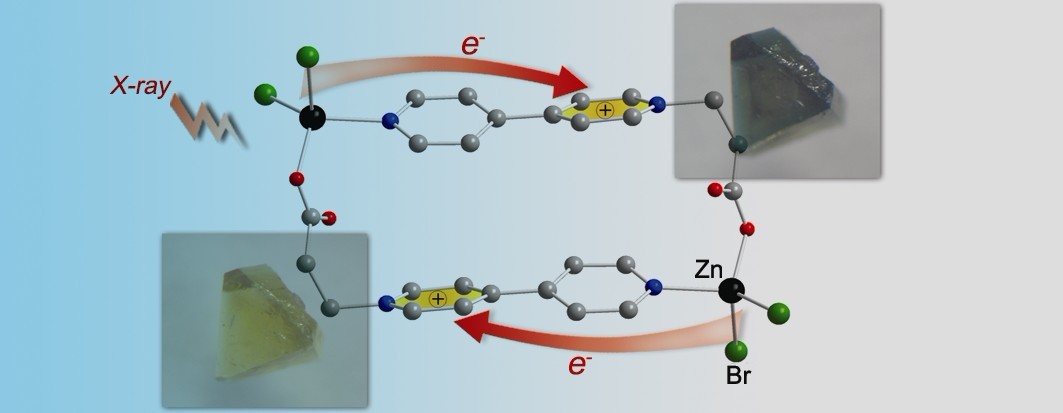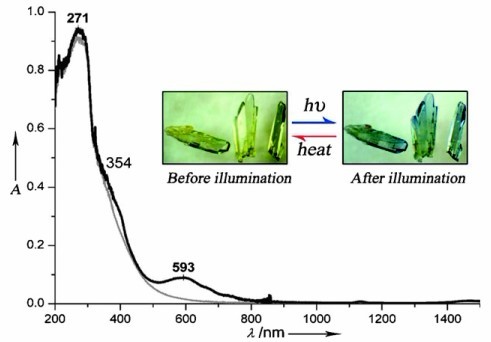Photochromic materials have real or potential applications in protection, display, high-density memory, switch, and many other high-tech areas. A current focus of study in this area is to exploit new materials with better photochromic performances or various switching functions, such as luminescence, electric conductivity, magnetism, and catalysis.
The research group headed by Prof. GUO Guocong at Fujian Institute of Research on the Structure of Matter (FJIRSM), Chinese Academy of Sciences(CAS),has made a series of progress in photochromic materials.
1) Reporting a new room-temperature X-ray-induced photochromic metal complex, and revealing its new X-ray-induced ligand-to-ligand charge-transfer mechanism ( Angew. Chem. Int. Ed., 2012, 51, 3432–3435, Figure 1). Such species can serve as ideal X-ray detection materials, because they are recyclable and also X-rays can be “viewed” directly in color by means of them.

Figure 1: X-ray-induced photochromism of a metal complex with a molecular structure(Image by Prof. GUO Guocong's group)
2) Discovering the redox photochromic behavior of N-methyl-4,4’-bipyridinium (MQ+) salts and their metal complexes, which develops the well-known viologen-based redox photochromic system (Inorg. Chem., 2012, 51, 4015−4019, Figure 2).

Figure 2: Photochromism of metal complexes of the MQ+ ligand (Image by Prof. GUO Guocong's group)
3) Developing new photochromic hybrids of metal halides using the viologen and N-alkyl-aniline analogue cations (Angew. Chem. Int. Ed., 2007, 46, 3249–3251, Figure 3; Angew. Chem. Int. Ed., 2008, 47, 4149–4152), and observing their switchable solid-state photoluminescence and interesting partial photochromic phenomenon (Dalton Trans., 2010, 39, 8688–8692).

Figure 3: Photochromism of a bismuth(III) chloride-viologen hybrid (Image by Prof. GUO Guocong's group)
4) Opening up a new type of redox photochromic metal complex without photochromic precursors (Angew. Chem. Int. Ed., 2007, 46, 3909–3911, Figure 4), based on a new ligand-based electron-transfer mechanism (Chem. Commun., 2010, 46, 361–376, Feature Article).

Figure 4: Photochromism of a metal complex ([Cd2(ic)(mc)(4,4’-bipy)3]n×4nH2O) with nonphotochromic precursors (Image by Prof. GUO Guocong's group)
Contact:
Prof. GUO Guocong
Fujian Institute of Research on the Structure of Matter
Chinese Academy of Sciences
Email: gcguo@fjirsm.ac.cn